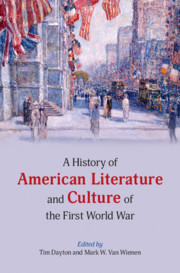Book contents
- A History of American Literature and Culture of the First World War
- A History of American Literature and Culture of the First World War
- Copyright page
- Contents
- Figures
- Contributors
- Acknowledgments
- Introduction America’s Great War at One Hundred (and Counting)
- Part I Genre and Medium
- Part II Settings and Subjects
- Part III Transformations
- Chapter 22 The Nation
- Chapter 23 Free Speech
- Chapter 24 Labor
- Chapter 25 The Veteran
- Chapter 26 The Military-Industrial Complex
- Chapter 27 The World
- References
- Index
Chapter 25 - The Veteran
Parades, Bitter Homecomings, and Fictions of the Doughboy’s Return
from Part III - Transformations
Published online by Cambridge University Press: 23 January 2021
- A History of American Literature and Culture of the First World War
- A History of American Literature and Culture of the First World War
- Copyright page
- Contents
- Figures
- Contributors
- Acknowledgments
- Introduction America’s Great War at One Hundred (and Counting)
- Part I Genre and Medium
- Part II Settings and Subjects
- Part III Transformations
- Chapter 22 The Nation
- Chapter 23 Free Speech
- Chapter 24 Labor
- Chapter 25 The Veteran
- Chapter 26 The Military-Industrial Complex
- Chapter 27 The World
- References
- Index
Summary
This chapter examines the notion of home-shock (as opposed to shell-shock) in five works of American fiction from the 1920s. Each work contains a veteran tortured not by war but by the circumstances of his homecoming. F. Scott Fitzgerald’s Jay Gatsby returns from his heroic overseas service to a nation that seems content to let him starve, the pivotal moment in his transformation from earnest student of self-help to criminal bootlegger. Harold Krebs, the protagonist of Ernest Hemingway’s “Soldier’s Home,” is infantilized by his mother and ignored by his community, which neither understands nor respects his combat experience. Bayard Sartoris and Henry Winston—former wartime aviators featured in, respectively, William Faulkner’s Flags in the Dust and Elliott White Springs’s Leave Me with a Smile—each suffer from paralyzing survivor’s guilt, a malady that no one in their Southern settings is equipped to treat. For African-American protagonists, subject to racial violence and oppression, home-shock is even more intense, as illustrated by the ironic fate visited upon Frederick Taylor, the doleful hero of Claude McKay’s “The Soldier’s Return,” set in a small Georgia town. This former soldier winds up on a chain gang after ignoring an edict that prohibits black veterans from wearing their uniforms in public.
Keywords
- Type
- Chapter
- Information
- Publisher: Cambridge University PressPrint publication year: 2021

